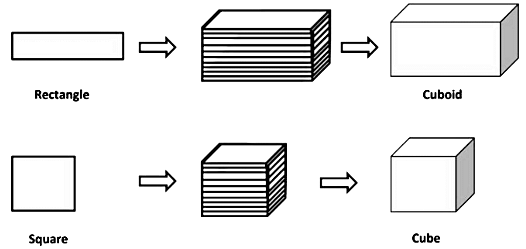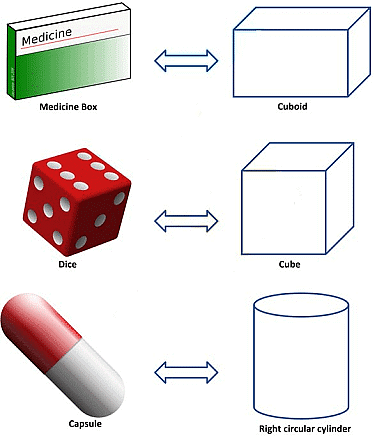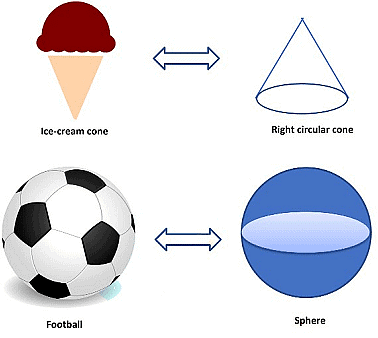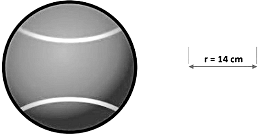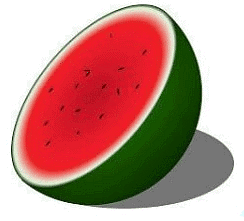Surface Area and Volumes Class 9 Notes Maths Chapter 12
| Table of contents |

|
| Introduction |

|
| Surface Area of Cones |

|
| Surface Area of Hemi-Sphere |

|
| Volume of a Cone |

|
| Volume of a Sphere |

|
| Volume of a Hemi-Sphere |

|
Introduction
Ever wondered how we measure the wrapping needed for a gift or the space inside a box? That's where surface area and volume come into play. Surface area is like the total paper to cover a 3D object, while volume is the space it occupies.
 Wrapping Paper
Wrapping Paper
It's how we quantify the 'outside' and 'inside' of shapes. So, how do we calculate these for different objects? Let's explore the answers by unraveling the mystery of surface area and delving into the 'roominess' of volume!
- Suppose, we cut out a circle shape from a cardboard sheet.
- Then we cut many such circles identical to the first one and then pile them up in a single column. [Shown in the figure] Then the shape we obtained will be a 3-dimensional shape
 By this process, we shall obtain some solid figures such as a cuboid and cube as shown below.
By this process, we shall obtain some solid figures such as a cuboid and cube as shown below.
- All solid objects occupy some space and have three dimensions - length, breadth, and height or depth.
- Three-dimensional (3-d)shapes have four parts that set them apart from 2-d shapes viz. faces, vertices, edges, and volume.
- Some real-life examples which resemble solid shapes as shown below.


Surface Area of Cones
Cones are three-dimensional geometric shapes characterized by a circular base that tapers to a single point called the apex or vertex. Picture an ice cream cone – it's a classic example.
The curved surface of a cone forms a lateral surface, and the distance from the apex to the base is the height. Cones appear in various contexts, from ice cream treats to traffic cones, and their properties make them intriguing in geometry and real-world applications. Calculating their surface area and volume involves understanding their unique geometric features.

Activity: Construction of a Cone
To understand the formation of a right circular cone, perform the following activity:
- Cut out a right-angled triangle ABC, with B being the right angle.
- Paste a thick string along one of the perpendicular sides, say AB.
- Rotate the triangle around the string. Observe the resulting shape — a cone.
- This cone has a vertex (point A), height (AB), radius (BC), and slant height (AC).
Curved Surface Area of a Cone
The curved surface area (CSA) of a cone is calculated using the formula:
Curved Surface Area=πrl
Here, r is the base radius, l is the slant height, and π is a constant.
Note: The relationship l2=r2+h2 can be derived from the cone's cross-section, where h is the cone's height.
If the base is closed, a circular piece of paper with an area of πr2 is required, adding to the total surface area.
Example: Find the curved surface area of a cone, if its slant height is 60 cm and the radius of its base is 21 cm.
Solution: The slant height of cone (l) = 60 cm
The radius of the base of the cone (r) = 21 cm
Now,
Curved surface area of the right circular cone = πrl = 22/7 x 21 x 60 = 3960 cm2
Therefore the curved surface area of the right circular cone is 3960 cm2
Total Surface Area of a Cone
Total Surface Area = CSA+πr2=πrl+πr2=πr(l+r)
Examples: Find the curved surface area of a right circular cone with a slant height of 10 cm and a base radius of 7 cm.
Solution: CSA=π×7×10=220cm2
Surface Area of Sphere
Spheres are perfectly round three-dimensional shapes, resembling balls or globes. Every point on the surface of a sphere is equidistant from its center. Think of a basketball or the Earth, which is nearly a sphere. Spheres have no edges or vertices.
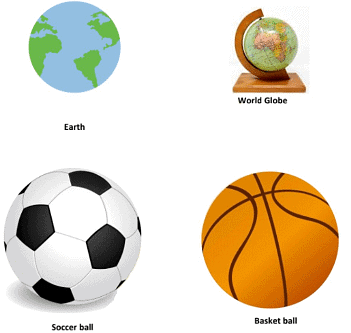
Surface Area of a Sphere
The surface area of a sphere is calculated as:
Surface Area=4πr2
Here, r is the sphere's radius.
Example: Find the surface area of a tennis ball of radius 14 cm.
Clearly, the tennis ball is in the form of a sphere.
Here, the radius of the sphere is 14 cm.
We know that,
Surface Area of the sphere =4πr2.
Therefore, the Surface Area of a tennis ball =4πr2.
= 4 × 22/7 × (14 cm)2.
= 4 × 22/7 × 14cm × 14 cm.
= 4 × 22 × 2cm × 14 cm.
= 2464 cm2.
Hence, the Surface area of the tennis ball is 2464 cm2.
Note: A sphere doesn't have separate curved and total surface areas because its entire surface is curved. In other words, there are no flat or planar sections on a sphere. The term "surface area" for a sphere typically refers to the total surface area, which includes both the curved surface area and the area of the sphere's base (which is also curved).
Surface Area of Hemi-Sphere
A hemisphere, being half of a sphere, has a surface area equal to 3/2 times the surface area of a sphere.

Surface Area of Hemisphere= 3/2×4πr2=3πr2
- Let us take a sphere, and slice it exactly through the middle with a plane that passes through its center.
- It gets divided into two equal parts. It is called the Hemisphere.
(Because 'hemi' also means 'half') Hemisphere: It has two faces one is a curved face and the other is a flat face (base). - The curved surface area of a hemisphere is half the surface area of the sphere,
which is 1/2 ×4πr2 .
Therefore,
Curved Surface Area of a Hemisphere = 2πr2
Where r is the radius of the sphere of which the hemisphere is a part.
Now taking the two faces of a hemisphere, its total surface area is 2πr2 + πr2.
So, the Total surface area of a hemisphere = 3 πr2.
Example: Find the curved surface area and the total surface area of the half slice of watermelon of radius 7 cm.
Clearly, half a slice of watermelon is in the form of a hemisphere.
Here, the radius of the hemisphere is 7 cm.
We know that,
The curved surface area of the hemisphere =2πr2.
Therefore, the Curved surface Area of half a slice of watermelon =2πr2.
= 2 × 22/7 × (7 cm)2.
= 2 × 22/7 × 7cm × 7 cm.
= 2 × 22 × 1cm × 7 cm.
= 308 cm2.
Hence, Curved Surface area of half a slice of watermelon is 308 cm2.
Also, we know that
The total surface area of hemisphere = 3πr2.
So, the total surface area of half a slice of watermelon = 3πr2.
= 3 ×227× (7 cm)2.
= 3 × 22/7 × 7cm × 7 cm
= 3 × 22 × 1cm × 7 cm.
= 462 cm2.
Hence, the total surface area of half slice of watermelon = 462 cm2.
What is Volume?
Volume refers to the amount of space occupied by a three-dimensional object. It is a measure of how much "stuff" or substance an object can hold. The concept of volume is often applied to various geometric shapes, such as cubes, spheres, cylinders, and cones.
Volume of a Cone
The volume (V) of a cone is calculated using the formula:
V= 1/3πr2h
Here, r is the base radius, and h is the height of the cone.
Example:
Given the height (h) and slant height (l) of a cone as 21 cm and 28 cm respectively, find the volume.
Solution: Slant height (l) = 28cm; Height of cone (h) = 21cm ; Let radius of cone = r cm
we know that,
Volume of a Sphere
The volume (V) of a sphere is given by the formula:
V= 4/3 πr3
Here, r is the radius of the sphere.
Example:
Find the volume of a sphere with a radius of 11.2 cm.
Solution:
Volume of a Hemi-Sphere
The volume of a hemisphere, being half of a sphere .
The volume (V) of a hemisphere (half of a sphere) can be calculated using the formula:
V= 2/3πr3
where:
- r is the radius of the hemisphere, and
- π is a mathematical constant approximately equal to 3.14159.
Example: A particular dome of a building is in the shape of a hemisphere. From inside, it was white-washed at the price of Rs. 4989.60. If the cost of white-washing is Rs 20 per square metre, find the
(i) The required inside surface area of the dome
(ii) The volume of the air inside the dome
Solution: (i) The cost of white-washing the dome from inside = Rs 4989.60
Cost of white-washing 1m² area = Rs 20
The curved surface area of the inner side of the dome = 498.96/2 m² = 249.48 m²
(ii) Let the required inner radius of the hemispherical dome be r.
Curved Surface Area of the inner side of dome = 249.48 m² (from (i))
Formula to find CSA of a hemisphere = 2πr²
2πr = 249.48
2×(22/7)×r² = 249.48
r² = (249.48×7)/(2×22)
r² = 39.69
r = 6.3
So, the radius is 6.3 m
The volume of air inside the given dome = Volume of hemispherical dome
Using the formula, the volume of the hemisphere = 2/3 πr³
= (2/3)×(22/7)×6.3×6.3×6.3
= 523.908
= 523.9(approx.)
The required volume of air inside the dome is 523.9 m³.
|
44 videos|412 docs|55 tests
|
FAQs on Surface Area and Volumes Class 9 Notes Maths Chapter 12
| 1. What is the formula for finding the surface area of a cone? |  |
| 2. How do you calculate the surface area of a hemi-sphere? |  |
| 3. What is the formula for finding the volume of a cone? |  |
| 4. How do you calculate the volume of a sphere? |  |
| 5. What is the formula for finding the volume of a hemi-sphere? |  |

|
Explore Courses for Class 9 exam
|

|
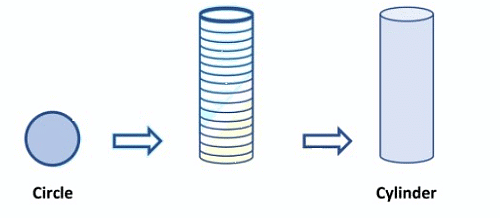 By this process, we shall obtain some solid figures such as a cuboid and cube as shown below.
By this process, we shall obtain some solid figures such as a cuboid and cube as shown below.